Renovations Fit For A King (or a Rover, a Fifi, or a Rex)
By Martha Uniacke Breen
Our pets are members of our families. Why not renovate to accommodate their needs as well as ours?
Grace & Co.’s in-house Design Manager, Sheila Shabsove, has noticed a significant increase in the number of dogs out on the boardwalk since the start of the pandemic – playing Frisbee or catch, running in the waves, or just trotting along happily on their leashes alongside their owners. “It’s really enjoyable to see so many people out here enjoying life with their pets,” laughs Sheila, who is a dog parent herself.
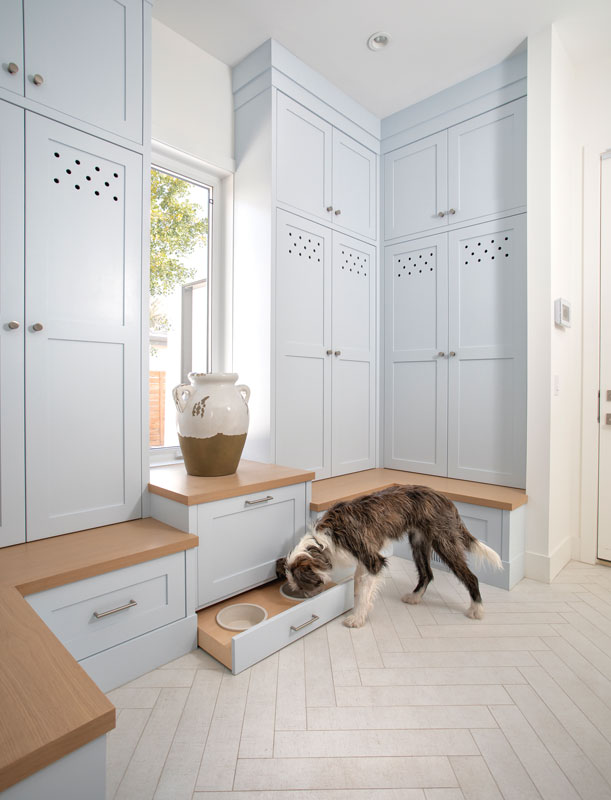
For many of us, our pets are full-fledged members of our families, entitled to just as much care and consideration as we give ourselves and our kids. And, as Sheila has observed, it’s led to a boom in requests for pet-related features to be incorporated into home renovations.
And why not? Any renovation should add convenience and efficiency as well as style to a kitchen or other room. Why shouldn’t pet-related amenities – from feeding stations to built-in bedding to food, toy & clothing storage (and all the other paraphernalia that comes with owning a happy pet) – be afforded the same consideration?
“The number-one need when it comes to our pets is storage,” observes Sheila. “And, as with any storage, the best place to start is just to think about what you need to store, and plan accordingly. Food bags or cans? Coats, boots, and other clothing? Litter and poop bags?” Easy access to items you use every day, being able to see at a glance when items need restocking, and creating a storage system à la Marie Kondo, are the top guidelines.
One option is built-in bins to hold kibble that you can just scoop out as needed, but this can be problematic; moisture or even insects can contaminate the food, and it can get stale if not used up quickly. A better alternative is to store dry pet food in its original bag with a secure closure on top or transfer it to airtight containers, stored close to where you feed the pet.
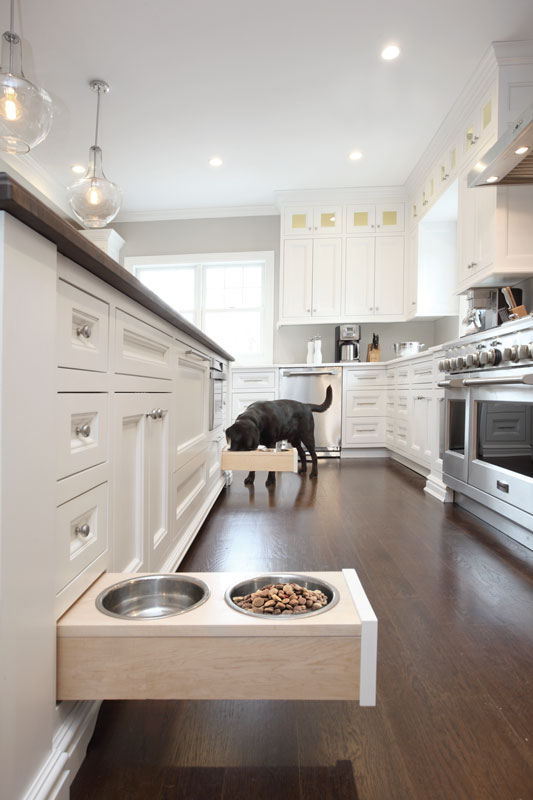
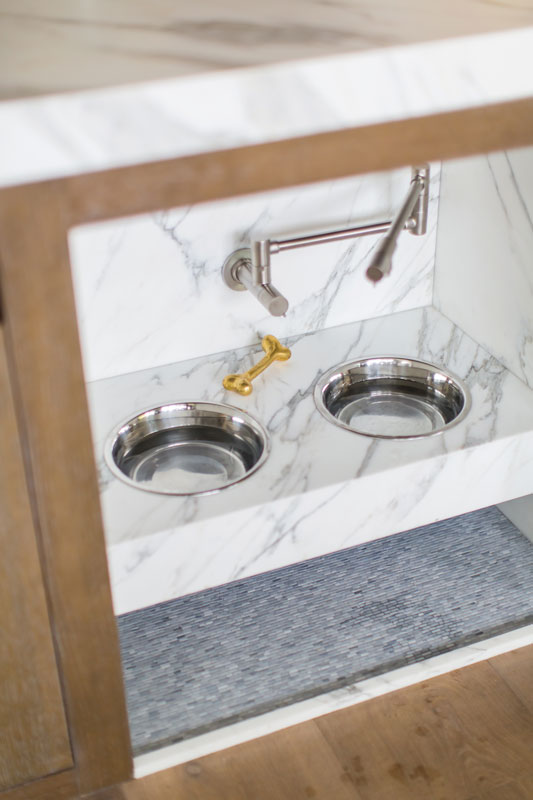
As for actual feeding stations, there are a wealth of smart options to consider. Sheila suggests one option could be a spring-loaded pullout drawer, built into a kitchen kickplate and equipped with a platform with cutout holes for the bowls. This allows you to pull out the drawer for feeding time; at the end of the meal, lift out and place bowls in the dishwasher, and push the drawer back out of sight.
Another option – a variation on the pot filler over your range – is a jointed pot filler near a dog bowl, making it easy to replenish their water when needed, without having to stoop and bring it up to the sink or worse, letting Duke go thirsty on a hot day.
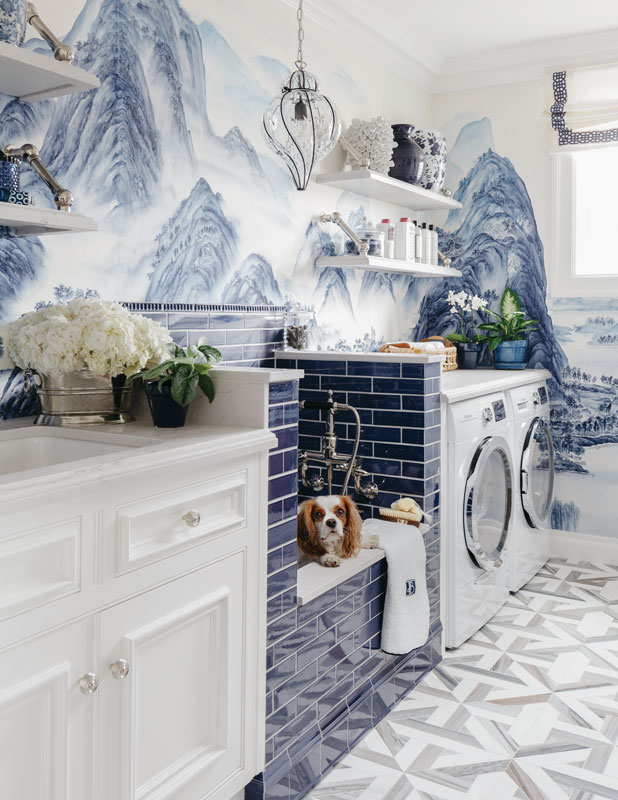
Especially for bigger dogs, or those who love to run on the beach or in the woods getting covered in sand and dirt, a dog washing station in the mudroom or somewhere near the back door is a real convenience. Some features to consider include tiled floors and sides, a handheld shower spray and a raised edge to hold water in. You could also add some kind of restraining harness, like those used in professional dog spas; being restrained during a bath actually seems to calm some dogs down. And lastly, it should be warm – a heated floor is sheer luxury to a wet pooch – and near to an electrical source for blowdrying.
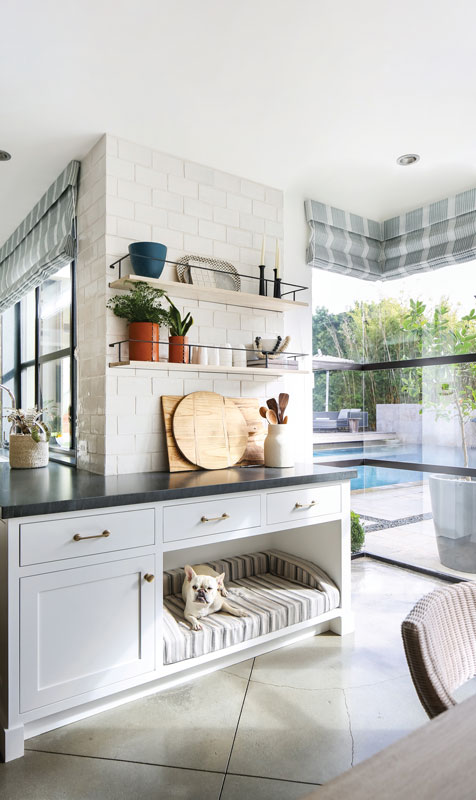
Sleeping areas are another growth area when it comes to bespoke pet comforts. Indoor “doghouses” (or at least pet bedrooms) are a stylish alternative to crates. As with other pet renovations, you can turn a cupboard into a pet boudoir by putting a swinging door on the front or leaving it open. A drawer lined with favourite blankets and pillows makes a comfy pet bed – either part of a built-in storage unit or in a dresser.
To take the idea a step further, Sheila has noticed that backyard doghouses have returned in a big way (though most vets do not recommend you leave dogs outside at night, where they are vulnerable to both predators and weather). She’s found the most attractive models mimic the style of their accompanying human house, with similar paint or siding, shingle roofing and even trim. Fancier models feature motion-sensitive lighting, heat and built-in food and water bowls.
One final piece of advice: Sheila cautions that it’s probably wise to at least think about resale when you install pet-friendly built-ins such as washing stations or comfort stations, unless you are planning to stay in your home for a long time. It could conceivably have an effect on resale if a future owner sees it as an expense to rip out and remodel.
“But I’m finding that’s not as true as it used to be,” she concedes. “Pets are becoming more and more popular, and some people might view a dog washing station as an asset!”
Contact sheila@gracehomes.com for more tips on your next home reno!
